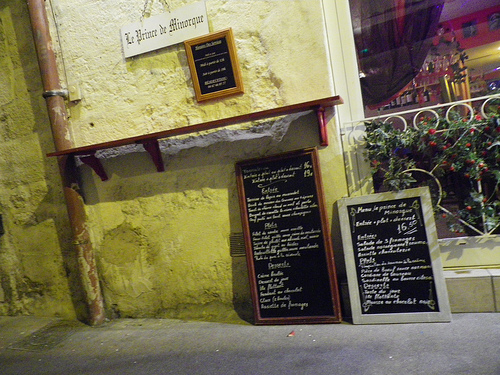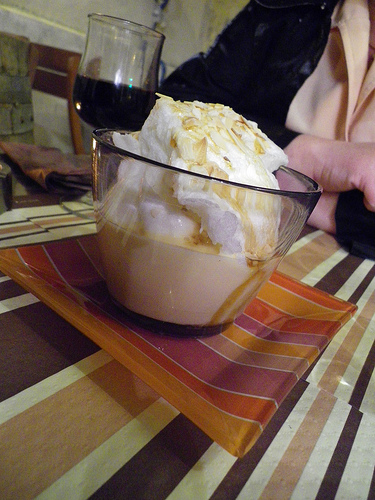 Any France travel guide will tell you about hotels, transportation, what to see when and how. And, a lot will give you a primer on how to read a French menu, too. But here on WhyGo France, you’re in good hands – the hands of a foodie who just polished off a plate of foie gras the size of a (burp) coffee table book. So if you’ve come looking for menu tips for France that won’t leave you hungry, you’ve come to the right place.
Any France travel guide will tell you about hotels, transportation, what to see when and how. And, a lot will give you a primer on how to read a French menu, too. But here on WhyGo France, you’re in good hands – the hands of a foodie who just polished off a plate of foie gras the size of a (burp) coffee table book. So if you’ve come looking for menu tips for France that won’t leave you hungry, you’ve come to the right place.
First, let’s go over what meals are called. (See my French pronunciation guide to get an idea of how these weird words should sound.)
- Breakfast – petit déjeuner (peh-tee day-zhoon-ay)
- Lunch – déjeune (day-zhoon-ay)
- Dinner – dîner (dee-nay)
Next we’ll go over the categories you’re likely to see on a menu.
Well, first of all, back up – you’ll see the word “menu” a lot, but it doesn’t mean what we English speakers think it does. Behold, the first key to mastering a French menu:
- Carte – what we think of as a menu; the thing the hostess gives you when you’re seated at a table.
- Menu – what we think of as “prix-fixe,” which ironically is a term they don’t use over here; it’s a set price for a certain number of courses.
- Menu dégustation – tasting menu.
- à la carte – stand-alone items, each with their own price.
Just so we’re clear in this article, I’m going to use “carte” and “menu” as the French do so we don’t get confused.
- First course – entrée (Yep, that’s right, what we’ve always thought of as the main dish is actually the first course.)
- Main dish – plat
- Salad – salade
- Soup – soupe
- Dessert – dessert
Now under the menu section of the carte, you’ll see a combination of choices available for various fixed prices.
- Entrée + plat
- Plat + dessert
- Entrée + plat + dessert
Then they’ll have choices for each category, on a separate page from the à la carte part of the carte, so you don’t get confused. As if you weren’t already confused enough as it is.
Next, we’ll run down some of the food you’ll see on cartes.
Viande – meat
- Boeuf – beef
- Bifteck – steak meat (but not usually presented as a steak)
- Entrecôte – a tenderloin steak on a plate.
- Faux-filet – a sirloin steak on a plate.
- Tartare de bœuf – this is ground beef with seasoning, served raw. Yes, I said raw. You’ve been warned.
- Porc – pork
- Agneau – lamb
- Mouton – mutton
- Veau – veal
- Cheval – horse
- Taureau – bull
- Lapin – rabbit
- Poulet – chicken
- Dinde – turkey
- Canard – duck
- Confit de canard – cured duck leg cooked in duck fat
- Magret de canard – roasted duck breast, usually served sliced
- Caille – quail
- Volaille – fowl; really, a catch-all word for any bird that’s not already mentioned above.
Poisson – fish
- Fruits de mer – seafood (Sometimes used as a carte category instead of “poissons;” otherwise, it usually means mixed seafood in a particular dish.)
- Homard – lobster
- Langoustine – langoustine (like a tiny lobster)
- Crevettes – shrimp (these are usually like you’re used to, i.e., peeled and ready to eat)
- Gambas – prawns (these usually come with the heads and shells on)
- Coquilles Saint-Jacques – scallops
- Thon – tuna
- Saumon – salmon
- Moules – mussels
- Moules frites – mussels with a side of fries, NOT fried mussels!
- Truite – trout
- Lieu – haddock or hake
- Morue, or cabillaud - cod (“morue” is sometimes used as an insult, FYI.)
- Loup – sea bass
- Calmar, calamar – calamari (squid)
- Poulpe – octopus
Légumes – vegetables
- Végétarien – vegetarian (Although this is not usually its own category, you can at least know the word to ask.)
- Haricots – beans
- Maïs – corn
- Epinards – spinach
- Oignon – onion
- Carottes – betcha can’t guess. Carrots!
- Salade mixte – a mixed green salad. This is as opposed to the salads under the “salades” portion of the carte, which are meal-sized and piled with amazing food
Pâtes – pasta
Accompagnement – side dish (You don’t see this often, but it does exist; almost all French restaurant main courses come with sides.)
- Pommes frites – French fries
- Aligot – a regional potato dish made with cheese. IF YOU SEE THIS, GET IT.
- Pommes Dauphinoise – potatoes baked in cream and garlic.
 Dessert – I believe this word needs no further translation.
Dessert – I believe this word needs no further translation.
- Tarte – pie
- Tarte tatin – like an apple pie, but ten times more amazing.
- Crème brûlée – a small pot of custard with sprinkled sugar on top that they burn with a torch.
- Mousse au chocolat – chocolate mousse
- Ile Flottante – a bowl of crème anglaise (thick sweet cream) with an “île” (island) of meringue floating in it.
- Mi-cuit au chocolat or chocolat fondant – half-baked mini chocolate cake, with a gooey center.
Other words you’ll see on a French restaurant carte:
- Assiette means a plate of something, like fromage (cheese) or charcuterie (cured meats).
- Poêlée – pan-fried
- Grillé – grilled
- Rôti – roast
- Poché – poached
- Cuit – cooked
- Cru – raw
- Frite – fried (as opposed to frites, which means French fries)
And some randoms:
- Côte or côtelette – chop, as in a pork chop or veal chop.
- Viande hachée – ground meat (minced meat)
- Anchois – anchovies. They show up in the weirdest places.
- Lardons – this translates to bacon, but don’t bust out the oeufs (eggs) just yet. Usually in small cubes, they’re more like a ham/pancetta meat. This usually comes on salads, or in pasta dishes. Sometimes, just because they’re French and fabulous, they’ll throw some on a plate as a garnish. Yes, that’s right – MEAT GARNISH.
One more note: When ordering meat, they’re going to ask you how you want it cooked. Note that the French do not believe in overcooking meat as it ruins the taste, and they don’t have the litigious society that in America turns a rare piece of steak into a law suit. So think about how you usually like your meat, and go one up from there.
- Saignant (sahn-yahnt)- rare (This literally means “bleeding;” you’ve been warned.)
- A point (ah pwanh) – medium
- Bien cuit (byen kwee) – well done
- Brûlé (broo-lee) – burnt
I’ll probably be adding to this as I continue to eat my way across France; in the meantime, make sure to check my other posts about food in France, French regional dishes you simply must try (or run from), how to order in a French restaurant, and many more to come! And please let me know if you want any specific translations in the comments – I’m more than happy to oblige.
 Any France travel guide will tell you about hotels, transportation, what to see when and how. And, a lot will give you a primer on how to read a French menu, too. But here on WhyGo France, you’re in good hands – the hands of a foodie who just polished off a plate of foie gras the size of a (burp) coffee table book. So if you’ve come looking for menu tips for France that won’t leave you hungry, you’ve come to the right place.
Any France travel guide will tell you about hotels, transportation, what to see when and how. And, a lot will give you a primer on how to read a French menu, too. But here on WhyGo France, you’re in good hands – the hands of a foodie who just polished off a plate of foie gras the size of a (burp) coffee table book. So if you’ve come looking for menu tips for France that won’t leave you hungry, you’ve come to the right place. Dessert – I believe this word needs no further translation.
Dessert – I believe this word needs no further translation.